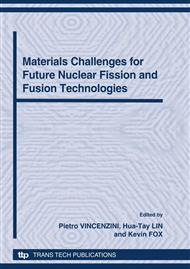p.124
p.130
p.136
p.142
p.148
p.158
p.171
p.176
p.183
An Innovative Hybrid Process Involving Plasma in a Cold Crucible Melter Devoted to the Futur Intermediate Level Waste Treatment: The SHIVA Technology
Abstract:
The cold crucible technology first developed for the treatment of the high level fission products can also be used for the direct treatment of intermediate level wastes. In this case, the wastes can be under the states of liquids or solids. The first experiments carried out for the direct treatment of ionic exchange resins emphasised the requirement of very high temperature on the surface of the glass. When this surface is to cold, the unperfected oxidation lead to a glass containing inclusion such as metallic compounds coming from the reduction of species contained in the waste. Thus, the quality of the glass could be not enough to meet with some specific requirements for long term storage. For few years, the Laboratory of the Innovative Processes has been studied the capability of a cold crucible to involved plasma torches ensuring the high temperature required for a complete oxidation of a large composition of waste. The developments and the assessment of different technological ways lead to build a cold crucible fitted with a bottom inductor together with twin plasma torches above the glass bath. This is the SHIVA process. The researches carried out on this innovative technology have shown the high efficiency of the combination for the treatment of a large variety of solid wastes. The oxidation is complete and the produced glass can be easily poured in a canister. This innovative process provides new perspective of treatment for a large variety of intermediate level waste stored on the ground of nuclear facilities.
Info:
Periodical:
Pages:
148-157
Citation:
Online since:
October 2010
Authors:
Price:
Сopyright:
© 2010 Trans Tech Publications Ltd. All Rights Reserved
Share:
Citation:


